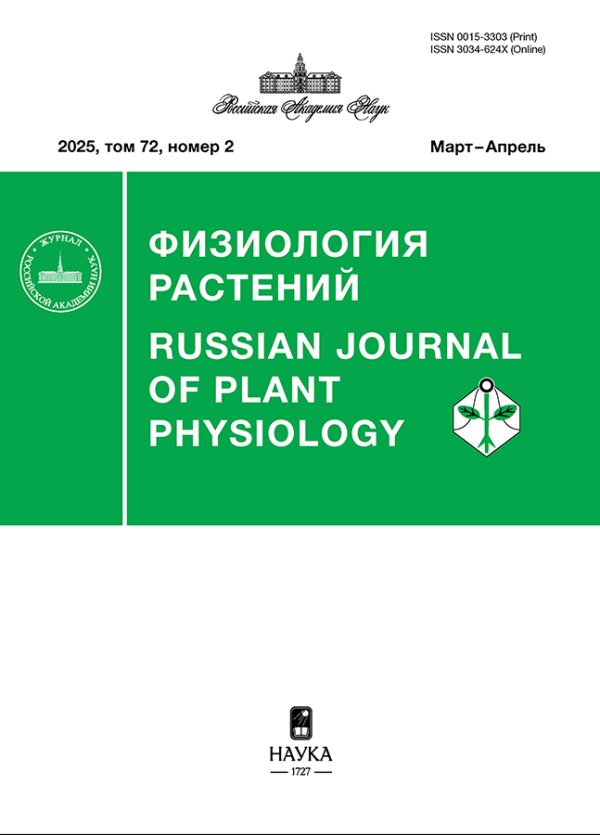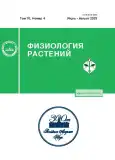INFLUENCE OF COPPER IONS ON GROWTH OF SMALL VASILISTNIK CELL CULTURE (THALICTRUM MINUS L.)
- Authors: Osipova E.A.1
-
Affiliations:
- Timiryazev Institute of Plant Physiology, Russian Academy of Sciences
- Issue: Vol 70, No 4 (2023)
- Pages: 410-416
- Section: ЭКСПЕРИМЕНТАЛЬНЫЕ СТАТЬИ
- URL: https://journals.rcsi.science/0015-3303/article/view/139786
- DOI: https://doi.org/10.31857/S0015330323600055
- EDN: https://elibrary.ru/PZWWYA
- ID: 139786
Cite item
Full Text
Abstract
Berberin compound with a wide range of biological activity, synthesized in the culture of cells of the medicinal plant Thalictrum minus. The influence of the abiotic elisitor (Cu2 +) on the growth of the Thalictrum minus cell culture and the biosynthesis of protoberberin alkaloids in it at different stages of the growth cycle was investigated. The rapid reaction (after 2 hours) and prolonged (at the end of the growth cycle) were evaluated. The greatest effect of increasing protoberberin alkaloids was observed after exposure to (Cu2 +) 20, 25 mg/L on day 0 after 2 hours, 49 and 114% above control, respectively, while maintaining growth at the control level. By the end of the growth cycle, cell mass and protoberberin alkaloids decreased by 67-70 and 27-53%, respectively (toxic effect). At 5 mg/L (Cu2 +), the reaction was the opposite.After 2 hours, 48% growth stimulation and 48% reduction in protoberberin alkaloids were observed with respect to control. By the end of the growth cycle, an excess of 50% was maintained, and the content of protoberberin alkaloids increased by 60% relative to control. If treatment with Cu2 + was carried out in the middle of the growth cycle, at a concentration of 20, 25 mg/L, both at the rapid reaction (after 2 hours) and at the end of the growth cycle, there was a decrease in growth by 65-71% and the content of protoberberin alkaloids by 52-70%. At 5 mg/l of copper ions, an excess of growth of 50-54% was maintained, the alkaloid content remained at the control level. The reaction at 10 mg/L of Cu2 + ions was intermediate. Studies have shown the promise of using low concentrations of copper ions for Thalictrum minus cell culture. The content of protoberberin alkaloids increased against the background of stimulation of cell culture growth at the end of the growth cycle.
About the authors
E. A. Osipova
Timiryazev Institute of Plant Physiology, Russian Academy of Sciences
Author for correspondence.
Email: eleang@mail.ru
Russian Federation, Moscow
References
- Максютина Н.П., Комиссаренко Н.Ф., Прокопенко А.П., Погодина Л.И., Липкан Г.Н. Растительные лекарственные средства. Киев.: Здоровя. 1985. С. 280.
- Холина А.Б., Журавлев Ю.Н. Культура клеток растений, как источник проторбербериновых алкалоидов // Растительные ресурсы. 1996. Вып. 1. С. 134.
- Song D., Hao J., Fan D. Biological properties and clinical applications of berberine // Front Med. 2020. V. 14. P. 564. https://doi.org/10.1007/s11684-019-0724-6
- Потопальский А.И., Петличная Л.И., Ивасивка С.В. Барбарис и его препараты в биологии и медицине. Киев.: Изд-во Наук. думка. 1989. С. 287.
- Thirupurasundari C.J., Padmini R., Devaraj S.N. Effect of berberine on the antioxidant status, ultrastructural modifications and protein bound carbohydrates in azoxymethane-inuced colon cancer in rat // Chemico-Biological Interactions. 2009. V. 177. P. 190. https://doi.org/10.1016/j.cbi.2008.09.027
- Rauf A., Abu-Izneid T., Khalil A.A., Imran M., Shah Z.A., Mitra S., Khan Z., Alhumaydhi F.A., Aljohani A.S M., Rahman Md.M., Jeandet P., Gonda T.A. Berberine as a potential anticancer agent: a comprehensive review // Molec. 2021. V. 26. P. 7368. https://doi.org/10.3390/molecules26237368
- Xiong R.G., Huang S.Y., Wu S.X., Zhou D.D., Yang Z.J., Saimaiti A., Zhao C.N., Shang A., Zhang Y.J., Gan R.Y., Li H.B. Anticancer effect and mechanism of berberine from medicinal herbs: an update review // Molec. 2022. V. 15. P. 4523. https://doi.org/10.3390/molecules27144523
- Kulkarni S.K., Dhir A. On the mechanism of antidepressant-like action of berberine chloride // Europ. Pharmacol. 2008. V. 589. P. 163. https://doi.org/10.1016/j.ejphar.2008.05.043
- Kong W., Wei J., Abidi P., Lin M., Inaba S., Li C., Wang Y., Wang Z., Si S., Pan H., Wang S., Wu J., Wang Y., Li J., Jiang J.D. Berberine is a novel cholesterol-lowering drug working through a unique mechanism distinct from statins // Nat. Med. 2004. V. 10. P. 1344. https://doi.org/10.1038/nm1135
- Jia X., Chen Y., Zidichouski J., Zhang J., Sun C., Wang Y. Co-administration of berberine and plant stanols synergistically reduces plasma cholesterol in rat // Athersclerosis. 2008. V. 201. P. 101.
- Jiang W.X., Li S.H., Li X.J. Therapeutic potential of berberine against neurodegenerative diseases // Sci. Chin. 2015. V. 58. P. 564. https://doi.org/10.1007/s11427-015-4829-0
- De Oliveria J.S., Abdalla F.H., Dornelles G.L., Adefegha S.A., Palma T.V., Signor C, Bernardi J. da S., Baldissarelli J., Lenz L.S., Magni L.P., Rubin M.A., Pillat M.M., Andrade C.M. Berberine protects against memory impairment and anxiogenic-like behavior in rats submitted to sporadic Alzheimer`s-like dementia: Involment of acetilcholinesterase and cell death // Neurotoxicologe. 2016. V. 57. P. 241. https://doi.org/10.1016/j.neuro.2016.10.008
- Yuan N.-N., Cai C.-Z., Wu M.-Y., Su H.-X., Lu J.-H. Neuroprotective effects of berberine in animal models of Alzheimer’s disease: a systematic review of pre-clinical studies // BMC Complement Altern Med. 2019. V. 23. P. 109. https://doi.org/10.1186/s12906-019-2510-z
- Гаммерман А.Ф., Кадаев Г.Н., Яценко-Хмелевский А.А. Лекарственные растения. М.: Изд-во Высшая школа. 1990. С. 544.
- Ikuta A., Itokawa H. Berberine and other protoberberine alkaloids in callus tissue of Thalictrum minus // Phytochem. 1982. V. 21. P. 1419.
- Сараев И.В., Величко Н.А., Репях С.М. Химический состав василистника малого Thalictrum minus L. // Химия растительного сырья. 2000. № 1. С. 37.
- Бутенко Р.Г. Клеточные технологии для получения экономически важных веществ растительного происхождения // Культура клеток растений и биотехнология. М.: Изд-во Наука. 1986. С. 3.
- Nakagawa K., Fukui H., Tabata M. Hormonal regulation of berberine production in cell suspension cultures of Thalictrum minus // Plant Cell Rep. 1986. V. 5. P. 69. https://doi.org/10.1007/BF00269722
- Hara M., Kitamura T., Fukui H., Tabata M. Induction of berberine biosynthesis by cytokinins in Thalictrum minus cell suspension cultures // Plant Cell Rep. 1993. V. 12. P. 70. https://doi.org/10.1007/BF00241937
- Hara M., Morio K., Yazaki K., Tanaka S., Tabata M. Separation and characterization of cytokinin-inducible (S)-tetrahydroberberine oxidases controlling berberine biosynthesis in Thalictrum minus cell cultures // Phytochem. 1995. V. 38. P. 89. https://doi.org/10.1016/0031-9422(94)00623
- Осипова Е.А. Агробактериальная трансформация культуры клеток василистника малого (Thalictrum minus L.) // Известия Самарского научного центра Российской академии наук. 2018. Т. 20. С. 447.
- Осипова Е.А., Цыбулько Н.С., Шамина З.Б. Вариабельность клеточных клонов Thalictrum minus in vitro // Физиология растений. 1999. Т. 46. С. 908.
- Карпун Н.Н., Янушевская Э.Б., Михайлова Е.В. Механизмы формирования неспецифического индуцированного иммунитета у растений при биогенном стрессе // Сельскохозяйственная биология. 2015. Т. 50. С. 540. https://doi.org/10.15389/agrobiology.2015.5.540rus
- Ramakrishna A., Ravishankar G.A. Influence of abiotic stress signals on secondary metabolites in plants // Plant Signal Behav. 2011. V. 6. P. 1720. https://doi.org/10.4161/psb.6.11.17613
- Siatkaa T., Chlebekb J., Hošťálkováb A. Copper (II) sulfate stimulates scopoletin production in cell suspension cultures of Angelica archangelica // Nat. Product Commun. 2017. V. 12. P. 1779.
- Kartosentono S., Indrayanto G., Zaini N.C. The uptake of copper ions by cell suspension cultures of Agave amaniensis, and its effect on the growth, amino acids and hecogenin content // Plant Cell, Tissue Organ Cult. 2002. V. 68. P. 287.
- Bhuiyan N.H., Adachi T.J. Stimulation of betacyanin synthesis through exogenous methyl jasmonate and other elicitors in suspension-cultured cells of Portulaca // Plant Physiol. 2003. V. 160. P. 1117. https://doi.org/10.1078/0176-1617-01044
- Томилова С.В., Кочкин Д.В., Галишев Б.А., Носов А.М. Влияние повышенных Концентраций ионов меди на ростовые характеристики и синтез стероидных гликозидов в суспензионной культуре клеток Tribulus terrestris L. // Биотехнология. 2019. V. 35. P. 42.
- Осипова Е.А. Влияние биотического стресса на содержание протобербериновых алкалоидов в суспензионной культуре клеток Thalictrum minus L. Ученые записки Крымского федерального университета им. В.И. Вернадского // Биология. Химия. 2020. Т. 6. С. 125.
- Murashige T. A revised medium for repid growth and bioassays with tobacco tissue cultures Murashige T. and Skoog F // Physiol. Plant. 1962. V. 15. P. 473. https://doi.org/10.1111/j.1399-3054.1962.tb08052
- Loeffer S., Zenk M.N. Hydroxylation step in the biosynthetic pathway leading from norcociaurine to reticuline // Phytochem. 1990. V. 29. P. 3499.
- Frenzel T., Zenk M.N. S-adenosyl-L-methionine: 3´-hydroxy-N-methyl (S)-cjclaurine-4-O-Methiltransferase, a region-and streoselectiveenzyme of the (S)-reticuline pathway // Phytochem. 1990. V. 29. P. 3505.
- Staba J.E. Plant tissue culture as a technique for the phytochemistry Staba J.E. // Resent Adv. In Phytochem. 1969. V. 2. P. 80.
- Цыбулько Н.С., Осипова Е.А. Метод определения протобербериновых алкалоидов в культуре ткани василистника // Химико-фармацевтический журнал. 1999. Т. 33. С. 34.
- Fang Y., Smith M.A.L., Pépin M.F. Effects of exogenous methyl jasmonate in elicited anthocyanin-producing cell cultures of ohelo (Vaccinium pahalae) // In Vitro Cell. Dev. Biol. Plant. 1999. V. 35. P. 106.
- Humberto A.-B.H., Vazques-hemandes M.C., Saenz de la O.D., Alvarorado-Mariana A., Guevara-Gonzales R.G., Garcia-Trejo J.F., Feregrino-perez A.A. Role of stress and defense in plant secondary metabolites production // Bioactive Natural Products for Pharmaceutical Applications. 2020. P. 15.
Supplementary files










